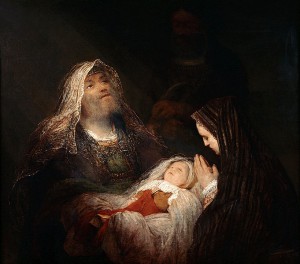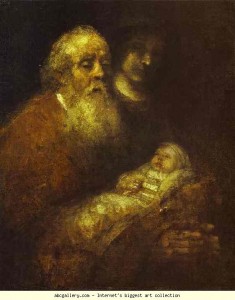Guided by the Spirit, Simeon came into the temple; and when the parents brought in the child Jesus, to do for him what was customary under the law, Simeon took him in his arms and praised God, saying, “Master, now you are dismissing your servant in peace, according to your word; for my eyes have seen your salvation, which you have prepared in the presence of all peoples, a light for revelation to the Gentiles and for glory to your people Israel.” [Luke 2:27-32, NRSV]
[L] Simeon’s Moment, by Ron DiCianni. [M] Simeon’s Song of Praise, by Aert de Gelder, early 18C. [R] Simeon’s Song of Praise by Rembrandt, 1669.
Ron DiCianni has painted a very captivating piece. The brief commentary that comes with the Simeon’s Moment says it all:
- To hold the Son of God in your arms has to be an awesome experience! For Simeon it was indeed the moment of a lifetime as it showed the fulfillment of God’s promise to him and to the world. Simeon’s Moment speaks to the joy and elation that Simeon must have felt at seeing that prophecy fulfilled. As the Michael Card song so beautifully describes in words and this painting so powerfully displays, this is the moment that Simeon had lived his life for. Luke 2:21-35.
Mary and Joseph have brought the infant Jesus to the temple for purification [Luke 2:22]. After the birth of Jesus, as Luke continues narrating the Good News of the Christ, he shortlists a man and a woman at the temple to witness to the infant’s true identity. Through the testimony of both a prophet and a prophetess, Simeon and Anna, God’s plan unfolds under Luke’s pen.
A Heritage of Devotion
Mary and Joseph are law-abiding Jews. Their trip to the temple to perform sacrifices fulfills the young mother’s purification forty days after giving birth [Leviticus 12:2-4, 6].
Furthermore, the firstborn child is to be set aside to the Lord [Luke 2:23; Exodus 13:2, 12, 16; 34:19; Numbers 18:15-16].
For sacrifices, they offer a pair of turtledoves or two young pigeons [Luke 2:24; Leviticus 5:7]. This offering is the one usually made by the poor, even though Joseph and Mary do not live in abject poverty, as Joseph is a carpenter by trade.
In this narrative, Luke is making it clear that Jesus’ parents are not spiritual renegades, but Jews who are sensitive and faithful to the Mosaic law. This motif of religious faithfulness is reinforced in Luke 2:40-52, when they will make their customary annual pilgrimage to Jerusalem.
The picture is clear: All those people surrounding Jesus at his birth have a heritage of devotion to God. The testimonies to Jesus, Luke is saying, stand solidly upon a series of religiously respectable figures. They are reliable.
When Luke wrote this Gospel many years after Jesus had left the world, he was not writing a biography of Jesus or a history. He was writing a theological explanation of Jesus, a deeper sense of what Jesus’ coming into the world meant. He wants us to see in this child the one who not only saves us from exile and from suffering and death, but who brings us the life of God — God’s very self. Jesus, Luke is telling us, is Saviour, Messiah, and God. Now, as he takes the story to the temple for the first time, he wants to not only deepen our understanding and strengthen the witness, but to also give us a sense of the suffering the Messiah and those closest to him will have to endure.
Thus Simeon and Anna enter into Luke’s narrative.
Simeon the Prophet
Led by the Spirit to the temple to greet Jesus, Simeon is described by Luke as “righteous and devout” (2:25). A man who walks closely with God, his piety includes a desire to see the hope of God’s redemption. On this religious man of Jerusalem who has been waiting for the consolation of Israel, Luke says the Holy Spirit has rested and revealed to him that he would not see death until his eyes have seen the Christ of the Lord. In the Christ lies Israel’s hope for deliverance. The Holy Spirit is in charge, directing the scenes. Behind Simeon’s prophecy, therefore, stand God’s promise, fulfillment and direction.
The name Simeon means ‘harkening’, so as a child he would be ‘a little listener’, hearing adults telling stories of the great deliverers of Israel. He would learn that the Lord Almighty had chosen them, the Jews, above all nations. When they would cry out to God, He would rescue them. God used men and women from all kinds of backgrounds to liberate them from their enemies. As a child, Simeon harkened to those days, those stories, of faith-filled heroes like Gideon and Samson, Deborah and Esther, Joshua and Elijah. These stories would stir up a hope deep in his soul to see the Lord’s hand of deliverance once again. In the old days, it was the Philistines, the Babylonians, or the Assyrians. Today, it is the Romans. They occupy the holy city, demanding taxes and tributes to their Caesar, and using some Jews as tax collectors and Jewish young men as free labourers. It is all like they are back in the days of slavery in Egypt. Israel is a desperate and sorrowful sight. How Simeon yearns for the mighty hands of God to deliver them again.
But many say in despair that the Lord has abandoned the Jews, for they are a God forsaken nation of repeat-rebels. These people have forgotten the promise God made to His people. Simeon knows better: God is faithful; He will send a Messiah. The ancient scrolls speak of One who would be born in Bethlehem, from the root of Jesse, the tribe of Judah, the son of David. He would be a deliverer, setting them free once and for all from the foreign oppressors, and reign on the throne of David. His kingdom established in Israel would have no end.
In old age, Simeon has a singular wish: he longs to see this Messiah before he dies. He has listened and listened hard, and he heard something that has thrilled his soul. The Holy Spirit of the Almighty told him that he would see this Messiah with his own eyes before he tasted death. He has been waiting a long time for this day. And the day has come.
As he stood in the temple and ministered to the Lord, a couple came in with an infant, to dedicate Him to the Lord. As they stepped into the court where Simeon was worshiping, his spirit leapt for joy. He knew at once that this infant was the One, the Promised Messiah.
The superiority of Jesus over the Baptist
In chapter 1, Luke delivers a glorious testimony about John the Baptist. But that testimony stops at his circumcision. In chapter 2, Luke will now highlight Jesus’ superiority to John, the praises of Jesus extending long past the eighth day of life, and they come from people far and near, of different walks of life and not just confined to his immediate family.
Simeon’s Prophecy (2:25-35)
Beholding the Child Jesus, Simeon bursts forth in words and actions captured by Luke in two parts.
Set within a hymn known as the Nunc Dimittis, Part I has Simeon declaring Jesus as the salvation which God has prepared for all nations. To see Jesus is to see God’s salvation. The two are inextricably bound. His eyes having seen God’s salvation, Simeon knows his time is up and is ready to go. In Simeon, we see a faithful servant of God who is at home in God’s purpose and plan. And in such a faithful servant, we see the manifestation of joy even in the proximity of death.
Here is a wise prophet of Jewish piety speaking not only for the nation but for all humankind, as Simeon’s prophecy mentions Jesus’ relationship to the Gentiles.
All is good and wonderful. And yet, there is a Part II. For in the face of such extensive grace, however, Luke introduces a harsh reality. His narrative goes on immediately to provide the first hint that all will not go well. Luke relates a note of foreboding that Simeon leaves with Mary.
- Jesus will be the cause of division: “This child is destined to cause the falling and rising of many in Israel.”
- He will divide the nation in two: while some will respond well to him, others will be vehemently opposed to him.
- People will contend against and about Jesus, so that the road to promise-fulfillment is filled with severe obstacles.
- Jesus will be rejected by many.
- To identify with him will bring pain.
- In particular, Mary will experience the mother’s pain, like a sword piercing her soul, of seeing her son rejected by a divided Israel.
How does all this affect us directly?
Even though Simeon’s remark to Mary is an aside, it is a very important one, so that readers of Luke’s Gospel also get the sense, a forewarning if you will, that anyone identifying with Jesus is heading for painful personal consequences. At the same time, Luke also leaves no room for mediocre discipleship. In causing the divisions, Luke says Jesus will also lay bare the secret thoughts of many hearts. It is Jesus who will act as God’s litmus test for where a person really stands with God. Each person’s response to him comes from individual hearts.
Reading Luke, we join Jesus’ parents and have this sense of awe, wonder and indeed marvel at the prophecy uttered by Simon. It is, for us, a serious challenge.
But the cycle of sextet named witnesses has one more name yet, that of Anna’s. Luke leaves her till the end, and to Anna we shall turn in the next post.
Copyright © Dr. Jeffrey & Angie Goh, February 2015. All rights reserved.
You are most welcome to respond to this post. Email your comments to jeffangiegoh@gmail.com. You can also be dialogue partners in this Ephphatha Coffee-Corner Ministry by sending us questions for discussion.



